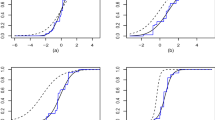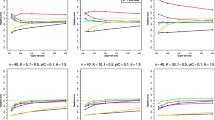Abstract
This paper studies a compound interval hypothesis about risk ratio in an incomplete correlated \(2\times 2\) table. Asymptotic test statistics of the Wald-type and the logarithmic transformation are proposed, with methods of the sample estimation and the constrained maximum likelihood estimation (CMLE) being considered. Score test statistic is also considered for the interval hypothesis. The approximate sample size formulae required for a specific power for these tests are presented. Simulation results suggest that the logarithmic transformation test based on CMLE method outperforms the other tests in terms of true type I error rate. A real example is used to illustrate the proposed methods.
Similar content being viewed by others
References
Agresti A (1990) Categorical data analysis. Wiley, New York
Anderson TW (1958) An introduction to multivariate statistical analysis. Wiley, New York
Garcia JJ, Blanca M, Moreno F, Vega JM, Mayorga C, Fernandez J, Juarez C, Romano A, de Ramon E (1997) Determination of IgE antibodies to the benzylpenicilloyl determinant: a comparison of the sensitivity and specificity of three radio allegro Sorbent test methods. J Clin Lab Anal 11:251–257
Gupta RC, Tian S (2007) Statistical inference for the risk ratio in \(2\times 2\) binomial trials with structured zero. Comput Stat Data Anal 51:3070–3084
Katz D, Baptista J, Azen SP, Pike MC (1978) Obtaining confidence intervals for the risk ratio in cohort studies. Biometrics 34:469–474
Lachenbruch PA, Lynch CJ (1998) Assessing screening tests: extensions of McNemar’s test. Stat Med 17:2207–2217
Lui KJ (1995) Confidence intervals for the risk ratio in cohort studies under inverse sampling. Biom J 37:965–971
Lui KJ (1998) Interval estimation of risk ratio between the secondary infection given the primary infection and the primary infection. Biometrics 54:706–711
Lui KJ (2000) Confidence intervals of the simple difference between the proportions of a primary infection and a secondary infection, given the primary infection. Biom J 42:59–69
Macaskill P, Walter SD, Irwig L, Franco EL (2002) Assessing the gain in diagnostic performance when combining two diagnostic tests. Stat Med 21:2527–2546
Okasha M (2005) Statistical inference for the rate ratio in a two-way contingency table with an empty cell. J Res Nat Sci 19:131–157
Schuirmann DJ (1987) A comparison of the two one-sided tests procedure and the power approach for assessing the equivalence of average bioavailability. J Pharm Biopharm 15:657–680
Tang ML, Tang NS, Carey VJ (2004) Confidence interval for rate ratio in a \(2\times 2\) tables with structural zero: an application in assessing false-negative rate ratio when combining two diagnostic tests. Biometrics 60:550–555
Tang NS, Tang ML (2003) Statistical inference for risk difference in an incomplete correlated \(2\times 2\) table. Biom J 45:34–36
Tang NS, Tang ML, Chan ISF (2003) On tests of equivalence via non-unity relative risk for matched-pair design. Stat Med 22:1217–1233
Tang NS, Tang ML, Wang SF (2007) Sample size determination for matched-pair equivalence trials using rate ratio. Biostatistics 8:625–631
Toyota M, Kudo K, Sumiya M, Kobori O (1999) High frequency of individuals with strong reaction to tuberculosis among clinical trainees. Jpn J Infect Dis 52:128–129
Wang SF, Tang NS, Wang XR (2006) Analysis of risk difference of marginal and conditional probabilities in an incomplete correlated \(2\times 2\) table. Comput Stat Data Anal 50:1597–1614
Wang SF, Wang XR (2007) Homogeneity test of risk differences of marginal and conditional probabilities in several incomplete correlated \(2\times 2\) tables. Commun Stat Theory Methods 36:2877–2890
Wang SF, Tang NS, Zhang B, Wang XR (2009) Statistical inference of risk difference in \(K\) correlated \(2\times 2\) tables with structural zero. Pharm Stat 8:317–332
Acknowledgments
This research is fully supported by grants from National Natural Science Foundation of China (10901135, 11261068, 11171293), Natural Science Foundation of Yunnan Province (2008CD081, 2010CC003) and Special Foundation for Middle and Young Excellent Reseachers of Yunnan University and Kunming. The authors are grateful to the editor and the reviewers for their valuable suggestions that greatly improve the paper.
Author information
Authors and Affiliations
Corresponding author
Rights and permissions
About this article
Cite this article
Wang, SF., Wang, XR. Statistical inference of risk ratio in a correlated \(2 \times 2\) table with structural zero. Comput Stat 28, 1599–1615 (2013). https://doi.org/10.1007/s00180-012-0368-3
Received:
Accepted:
Published:
Issue Date:
DOI: https://doi.org/10.1007/s00180-012-0368-3




